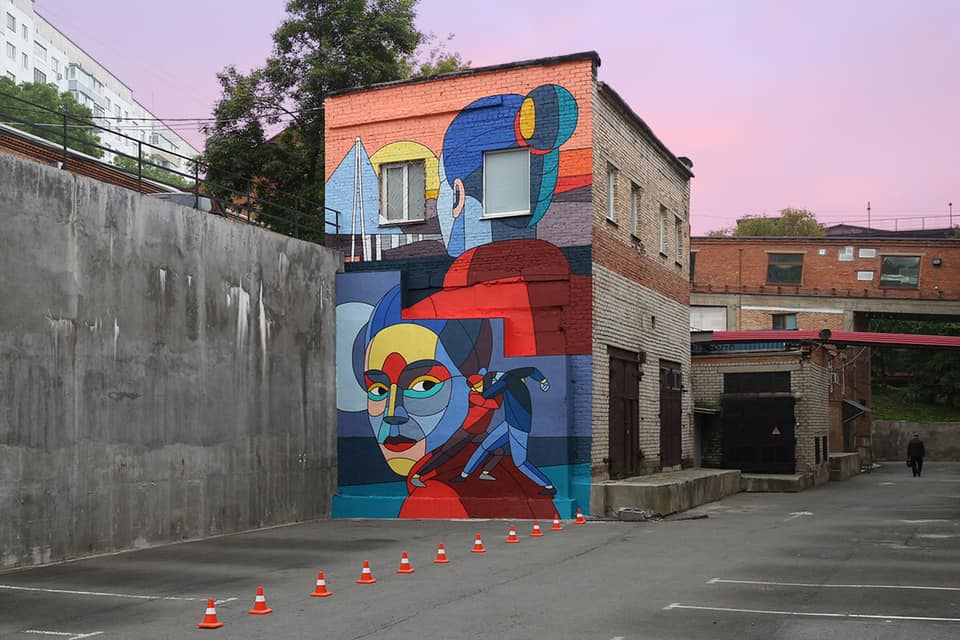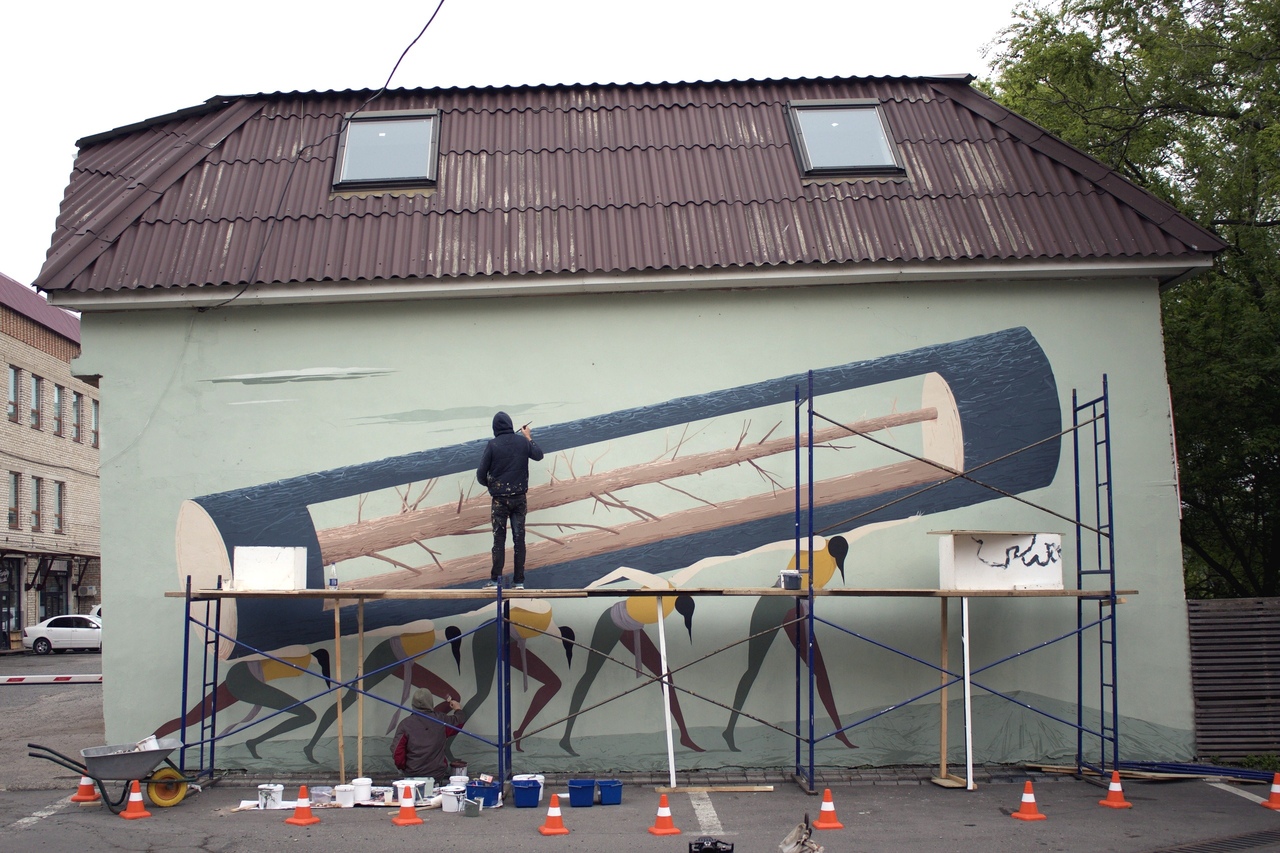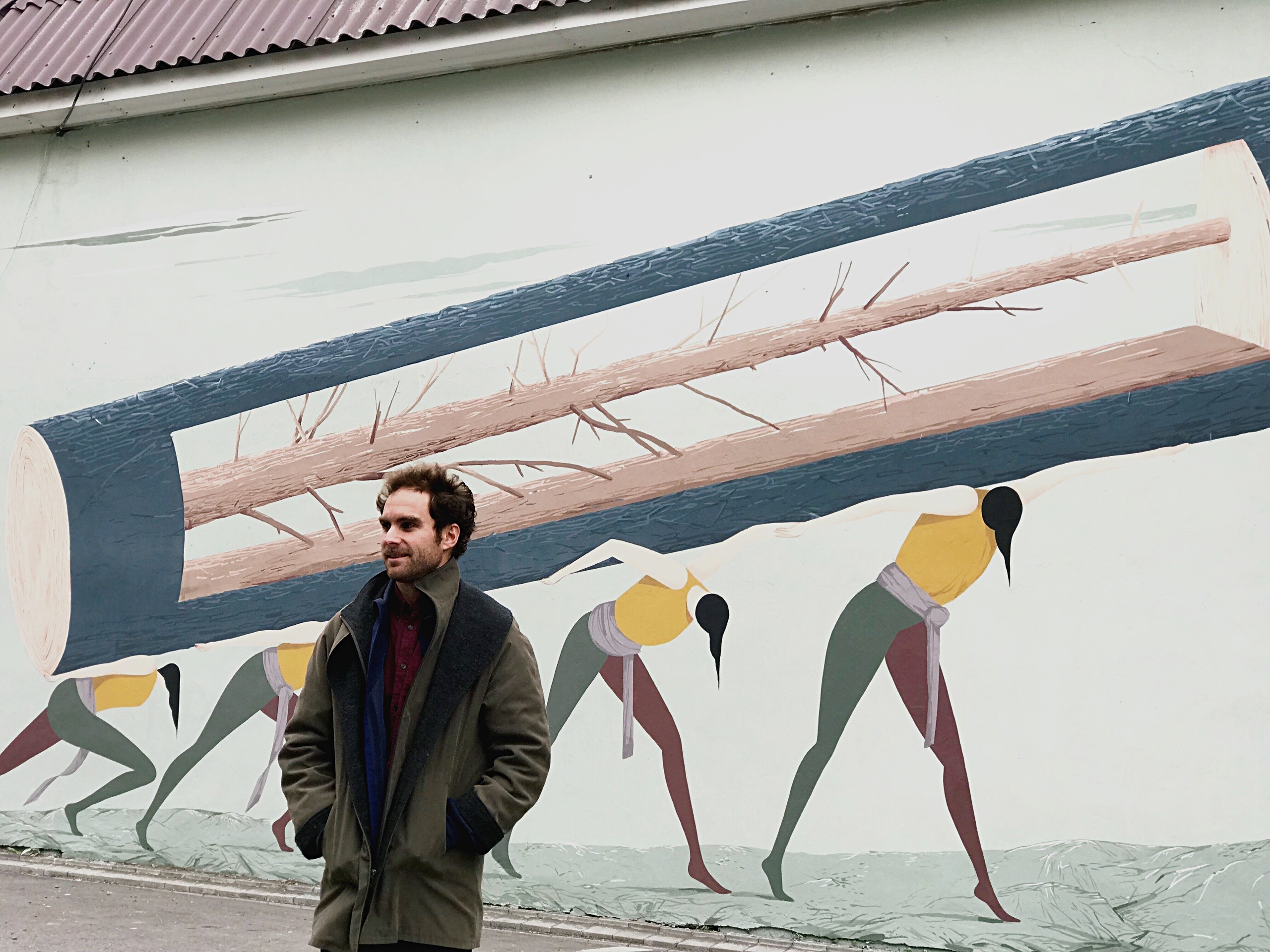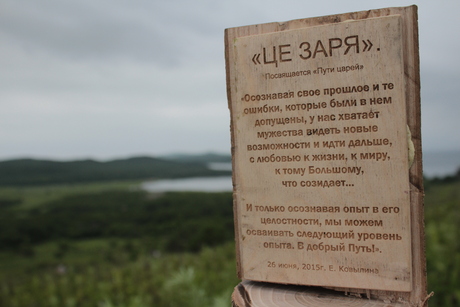
На территории Фабрики «Заря» появился новый арт-объект, созданный куратором выставки «Морская» –Дмитрием Аске в рамках V-ROX EXPO Festival.
Дмитрий Аске – московский художник и идеолог «уличной волны», ищущий баланс между визуальной и смысловой состовляющими своих произведений. «Поворотный момент» – это работа о внутренней борьбе и выборе пути в минуты принятия важных жизненных решений.

В рамках акции «Ночь музеев» (18 мая 2019) французский художник MioSHe обновил уличную территорию «Зари», расписав стену цеха № 7. На нашем YouTube-канале вы увидите подробности этого захватывающего процесса.
Сюжет, выбранный для Владивостока, – cтвол огромного кедра, который несут пятеро рабочих, – это отсылка к инсталляции скульптора Джузеппе Пенона «Версальский кедр» (Cedro di Versailles). Для Антуана было важным обратить внимание публики на отношения между людьми и деревьями. Это, разумеется, дань уважения: прежде всего природе, но также тяжелому человеческому труду и созидательной деятельности.
Проект состоялся при поддержке Французского Института в Санкт-Петербурге, Посольства Франции, культурного центра «Альянс Франсез-Владивосток» и Центра современного искусства «Заря».

ЦСИ «Заря» посетил французский художник-муралист и иллюстратор MioSHe. В рамках «Ночи музеев» он расписывал фреску на стене цеха № 7 (справа от главного входа в ЦСИ).
MioSHe (Антуан Мартине) – французский стрит-художник. Еще в школе он начал увлекаться граффити, потом по-настоящему полюбил расписывать стены. Работал в команде B2M, рисовал на улицах Нанта. Учился в Школе изобразительных искусств в Ренне. Во время учебы отшлифовал свое мастерство и стал иллюстратором-универсалом. Этикетки для винных бутылок, обложки для виниловых пластинок (еще два его увлечения), афиши и даже гигантские фрески для культурного центра Antipode в Ренне или для фестиваля Teenage Kicks – Антуан пробует все.
В 2009 вместе с художницей Эльзой Кентен (Elsa Quintin) MioSHe запускает проект Projet Pilot – они создают графические фризы с использованием одной лишь шариковой ручки.
Одно из последних достижений – проект Le Toboggan вместе с Бенито Лереем (Benito Leray): фантастическая сцена, возникшая на окраине квартала Клёне (Cleunay) в Ренне, в рамках фестиваля Urbaines 2014 (на видео).
Работая в самых разных форматах, MioSHe черпает идеи из своего уникального воображаемого бестиария. Отличительная черта его работ – странные и привлекательные персонажи-сатиры, наличие множества деталей и сюрреалистическая манера, из-за которой его часто сравнивают с Босхом. Муралы художника уже украсили стены домов в Париже, Ренне, Бордо и Нанте.
В этом году у MioSHe большое турне по России: Ростов-на-Дону, Самара, Екатеринбург, Новосибирск, Кронштадт, Владивосток. В каждом из городов художник создаёт настенную роспись. Сюжет, выбранный для Владивостока, – cтвол огромного кедра, который несут пятеро рабочих, – это отсылка к инсталляции скульптора Джузеппе Пенона «Версальский кедр» (Cedro di Versailles). Для MioSHe было важным обратить внимание публики на отношения между людьми и деревьями. Это, разумеется, дань уважения: прежде всего природе, но также тяжелому человеческому труду и созидательной деятельности.

МЕЖДУ 2 И 3 ЦЕХАМИ
Уличная территория Фабрики «Заря» пополнилась первым архитектурным арт-объектом! Беседка «Сень» от московской группы «Обледенение архитекторов» в лице Ильи Вознесенского и Алексея Кононенко создана специально для «Зари» и Владивостока под впечатлением от приморского климата, ветров и кораблей, ведь основаниями объекта являются самые настоящие мачты.
Фото Алексея Кононенко

ZARYA artist residency in Vladivostok.
Dedicaded to the «Parts to the Tsars»
In this performance, Vladivostok's Russky Island will serve as a metaphor for Russia and the Russian world.
I will sail a boat around Russky Island and at its highest point, I will insert a stake. This pin will be outfitted with the advanced technology of Noocvyaz (Krasnogorsk) so that anyone entering into its energy field will be able to reckon with his or her past mistakes and find the ability to move forward into the future, unencumbered.
The text engraved upon the stake reads:
“Aware of our past and the mistakes made along the way, we have the courage to see new opportunities and push on further, armed with a love for life, the world around us, and that something Bigger that fuels creation...
It is only by understanding our experiences in their entirety that we can move forward to the next level. Good luck!”
E. Kovylina, June 26, 2015
Vladivostok
Researching Vladivostok and its history, you come to understand how the city – while an extreme outpost of Russia – manages to encapsulate the essence of the entire country. Here you can find almost all of the key ideas underlying our country, including the discourse of the Russian empire and its greatness, its grandeur and vastness, the parable of its territorial ambitions. “From Lisbon to Vladivostok,” “from ocean to ocean,” “from Brest to Vladivostok” – these phrases map out the incomplete continuities of historical traditions, the gaps between successive historical epochs: the kingdom of Balhae; the empire of I Ching; the Tsarist era, known as the colonization of the furthest edges of the continent; the rupture between pre-revolutionary and Soviet life; and the Soviet and Post-Soviet period. In Vladivostok one feels a tremendous need for reconciliation between all these layers of life, all these ancestral spirits of the peoples and immigrants who once lived here, between the Red and the White, between the brutal history of the northern Gulags and the “ceremonial portrait” of the region. Vladivostok is a critical geopolitical point; by having it, we “have” the East. Here you can start to grasp the immeasurable expanse of our country, to understand the urgency of cultivating these territories. Herein lies the paradox of the Russian Empire, that in the big ideas, you lose the details.
The Triumphal Arch
In 1981, the last emperor of Russia, Nikolay I, then crown prince and heir to the throne, made a journey across Russia by water. As a monument to his visit, a Triumphal Arch was built in Vladivostok. The construction of this arch was considered as the first step in developing the Trans-Siberian Railway, which united otherwise unreachable areas of Siberia with the European part of Russia.
The Stake
In Vladivostok, there is the extraordinary symbolic site of Russky Island, host to a naval base and a university. At the end of the 19th century, about the same time the Triumphal Arch was built, the island gained a fortress with a paved dirt road. This road is truly remarkable, wide and solid and perfectly smooth. Modern asphalt roads in Russia often look far less sturdy than this clay-based one, hailing from a much earlier era. This road is lined with stakes, marking the milestones along the way.
Zarya
This performance is made possible through the support of the ZARYA artist residency in Vladivostok. In its past life, ZARYA was important for the region as a garment factory, located at a critical junction. In Russian, the word “Zarya” refers to the sunrise, the metaphorical dawn of a new day, a new journey, a new beginning in life. In pre-Petrine Rus, the people chose to call this “Tse Zarya.” Tse Zarya – Caesar – Tsar. The performance is dedicated to the “Journey of Tsars.”
“Aware of our past and the mistakes made along the way, we have the courage to see new opportunities and push on further, armed with a love for life, the world around us, and that something Bigger that fuels creation... It is only by understanding our experiences in their entirety that we can move forward to the next level. Good luck!”
Elena Kovylina